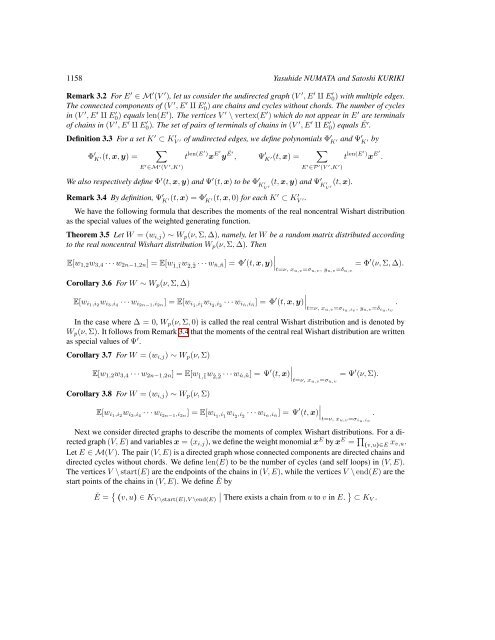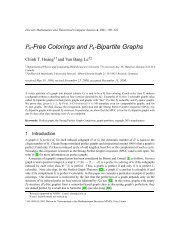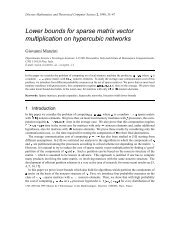On formulas for moments of the Wishart distributions as weighted ...
On formulas for moments of the Wishart distributions as weighted ...
On formulas for moments of the Wishart distributions as weighted ...
Create successful ePaper yourself
Turn your PDF publications into a flip-book with our unique Google optimized e-Paper software.
1158 Y<strong>as</strong>uhide NUMATA and Satoshi KURIKI<br />
Remark 3.2 For E ′ ∈ M ′ (V ′ ), let us consider <strong>the</strong> undirected graph (V ′ , E ′ ∐ E ′ 0) with multiple edges.<br />
The connected components <strong>of</strong> (V ′ , E ′ ∐ E ′ 0) are chains and cycles without chords. The number <strong>of</strong> cycles<br />
in (V ′ , E ′ ∐ E ′ 0) equals len(E ′ ). The vertices V ′ \ vertex(E ′ ) which do not appear in E ′ are terminals<br />
<strong>of</strong> chains in (V ′ , E ′ ∐ E ′ 0). The set <strong>of</strong> pairs <strong>of</strong> terminals <strong>of</strong> chains in (V ′ , E ′ ∐ E ′ 0) equals Ě′ .<br />
Definition 3.3 For a set K ′ ⊂ K V ′ <strong>of</strong> undirected edges, we define polynomials ′ Φ′ K and ′ Ψ′ K by ′<br />
∑<br />
Φ ′ K ′(t, x, y) =<br />
t len(E′) x E′ yĚ′ , Ψ ′ K ′(t, x) = ∑<br />
t len(E′) x E′ .<br />
E ′ ∈M ′ (V ′ ,K ′ )<br />
E ′ ∈P ′ (V ′ ,K ′ )<br />
We also respectively define Φ ′ (t, x, y) and Ψ ′ (t, x) to be Φ ′ K (t, x, y) and ′ Ψ′ V ′ K<br />
(t, x).<br />
′<br />
V ′<br />
Remark 3.4 By definition, Ψ ′ K ′(t, x) = Φ′ K ′(t, x, 0) <strong>for</strong> each K′ ⊂ K ′ V ′.<br />
We have <strong>the</strong> following <strong>for</strong>mula that describes <strong>the</strong> <strong>moments</strong> <strong>of</strong> <strong>the</strong> real noncentral <strong>Wishart</strong> distribution<br />
<strong>as</strong> <strong>the</strong> special values <strong>of</strong> <strong>the</strong> <strong>weighted</strong> generating function.<br />
Theorem 3.5 Let W = (w i,j ) ∼ W p (ν, Σ, ∆), namely, let W be a random matrix distributed according<br />
to <strong>the</strong> real noncentral <strong>Wishart</strong> distribution W p (ν, Σ, ∆). Then<br />
E[w 1,2 w 3,4 · · · w 2n−1,2n ] = E[w˙1,¨1 w˙2,¨2 · · · w ṅ,¨n] = Φ ′ ∣<br />
(t, x, y)<br />
= Φ ′ (ν, Σ, ∆).<br />
∣<br />
t=ν, xu,v=σ u,v, y u,v=δ u,v<br />
Corollary 3.6 For W ∼ W p (ν, Σ, ∆)<br />
E[w i1,i 2<br />
w i3,i 4<br />
· · · w i2n−1,i 2n<br />
] = E[w i w ˙1 ,i¨1 i · · · w ˙2 ,i¨2 iṅ,i¨n<br />
] = Φ ′ (t, x, y) ∣ .<br />
t=ν, xu,v=σ iu,iv , y u,v=δ iu,iv<br />
In <strong>the</strong> c<strong>as</strong>e where ∆ = 0, W p (ν, Σ, 0) is called <strong>the</strong> real central <strong>Wishart</strong> distribution and is denoted by<br />
W p (ν, Σ). It follows from Remark 3.4 that <strong>the</strong> <strong>moments</strong> <strong>of</strong> <strong>the</strong> central real <strong>Wishart</strong> distribution are written<br />
<strong>as</strong> special values <strong>of</strong> Ψ ′ .<br />
Corollary 3.7 For W = (w i,j ) ∼ W p (ν, Σ)<br />
E[w 1,2 w 3,4 · · · w 2n−1,2n ] = E[w˙1,¨1 w˙2,¨2 · · · w ṅ,¨n] = Ψ ′ ∣<br />
(t, x)<br />
∣<br />
t=ν, xu,v=σ u,v<br />
= Ψ ′ (ν, Σ).<br />
Corollary 3.8 For W = (w i,j ) ∼ W p (ν, Σ)<br />
E[w i1,i 2<br />
w i3,i 4 · · · w i2n−1,i 2n<br />
] = E[w i w ˙1 ,i¨1 i · · · w ˙2<br />
] = Ψ ′ (t, x)<br />
,i¨2 iṅ,i¨n ∣ .<br />
t=ν, xu,v=σ iu,iv<br />
Next we consider directed graphs to describe <strong>the</strong> <strong>moments</strong> <strong>of</strong> complex <strong>Wishart</strong> <strong>distributions</strong>. For a directed<br />
graph (V, E) and variables x = (x i,j ), we define <strong>the</strong> weight monomial x E by x E = ∏ (v,u)∈E x v,u.<br />
Let E ∈ M(V ). The pair (V, E) is a directed graph whose connected components are directed chains and<br />
directed cycles without chords. We define len(E) to be <strong>the</strong> number <strong>of</strong> cycles (and self loops) in (V, E).<br />
The vertices V \ start(E) are <strong>the</strong> endpoints <strong>of</strong> <strong>the</strong> chains in (V, E), while <strong>the</strong> vertices V \ end(E) are <strong>the</strong><br />
start points <strong>of</strong> <strong>the</strong> chains in (V, E). We define Ě by<br />
Ě = { (v, u) ∈ K V \start(E),V \end(E)<br />
∣ ∣ There exists a chain from u to v in E.<br />
}<br />
⊂ KV .






